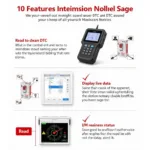Knowing the blue book value of your car is crucial when selling, trading in, or even just understanding your vehicle’s current market value. Whether you’re looking to upgrade to a newer model, navigate the intricacies of insurance claims, or simply want to stay informed, understanding how to determine your car’s blue book value is essential for any car owner.
What Exactly is “Blue Book Value” and Why Does it Matter?
The term “blue book value” is often used synonymously with a vehicle’s market value. It originates from the Kelley Blue Book, a long-standing resource in the automotive industry known for providing accurate and reliable vehicle valuations. While other reputable sources exist, the concept remains the same: offering a realistic estimate of what your car is worth in the current market.
But why is this value so important? Let’s break it down:
- Selling Your Car: When selling privately, knowing your car’s blue book value arms you with the knowledge to set a fair asking price. This attracts potential buyers and speeds up the selling process.
- Trading In: Dealerships often use blue book values as a baseline for trade-in offers. Understanding this value gives you leverage during negotiations, helping you secure the best possible deal.
- Insurance Claims: In unfortunate events like accidents or theft, insurance companies use blue book values to determine the payout for your vehicle. Knowing its worth beforehand ensures you receive fair compensation.
Factors Influencing Your Car’s Blue Book Value
Several key factors come into play when determining your car’s worth:
- Year, Make, and Model: This might seem obvious, but the older your car, the lower its value is likely to be. Similarly, popular models in high demand tend to hold their value better.
- Mileage: Lower mileage generally translates to a higher value.
- Condition: The overall condition of your vehicle, both mechanically and cosmetically, significantly impacts its worth. Regular maintenance and a well-maintained exterior go a long way.
- Location: Believe it or not, your geographical location can influence your car’s value. Supply and demand in your area, as well as regional preferences, can cause fluctuations.
- Options and Features: Added features like leather seats, sunroof, or advanced safety technology can positively influence your car’s value.
How to Find Your Car’s Blue Book Value
Gone are the days of relying solely on physical blue books. Today, accessing your car’s estimated value is easier than ever thanks to online resources:
- Kelley Blue Book (KBB): Still considered the gold standard, KBB’s website provides a user-friendly interface to input your car’s information and receive an instant valuation. kelley blue book value of my car
- Edmunds: Another trusted name in the industry, Edmunds offers similar valuation tools and resources for both private sellers and trade-ins.
- NADA Guides: The National Automobile Dealers Association (NADA) provides comprehensive pricing data often used by dealerships and financial institutions.
While these online tools are incredibly helpful, it’s important to remember that they provide estimates. For the most accurate valuation, consider getting a professional appraisal.
Beyond the Numbers: Factors Online Tools Don’t Always Capture
- Maintenance Records: A well-documented service history demonstrates responsible ownership and can boost your car’s perceived value.
- Modifications: While some modifications might be desirable, extensive or poorly executed ones can negatively impact your car’s value.
- Market Fluctuations: The automotive market is constantly evolving. Factors like economic conditions, gas prices, and even seasonal changes can influence valuations.
Expert Insight:
“Don’t underestimate the importance of presentation,” says John Smith, Senior Automotive Appraiser at XYZ Appraisals. ” A clean, detailed car makes a great first impression and can positively influence a potential buyer’s perception of its value.”
Negotiating with Confidence: Leveraging Your Blue Book Knowledge
When it comes to selling or trading in your car, knowledge is power. Having a solid understanding of your car’s blue book value empowers you to:
- Set Realistic Expectations: Avoid overpricing your car based on sentimental value or underselling yourself due to a lack of information.
- Negotiate Effectively: Whether you’re dealing with a private buyer or a dealership, having data to support your asking price strengthens your position.
Blue Book Value: Your Starting Point, Not Your Finish Line
Remember, the blue book value is a valuable tool, but it’s just one piece of the puzzle. Factors like market demand, your negotiation skills, and the specific condition of your vehicle all play a role in determining its final selling price.
By arming yourself with knowledge, researching thoroughly, and seeking professional advice when needed, you can confidently navigate the world of car valuations and make informed decisions when it comes to your vehicle.
FAQs about Blue Book Value
1. Is the blue book value the same as the trade-in value?
Not necessarily. While dealerships use blue book values as a reference point, trade-in values are often lower as dealers factor in reconditioning costs and profit margins. car value blue book
2. How often do blue book values update?
Blue book values are constantly updated to reflect market fluctuations, often on a weekly or even daily basis.
3. Can I dispute the blue book value of my car?
While you can’t directly change the blue book value, you can present evidence of your car’s excellent condition or unique features to justify a higher asking price.

